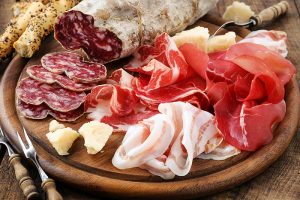
Any fool can know. The point is to understand – Albert Einstein
I have read all the books on the science of salami making and cured meat preserving. I have practiced it to quite a degree too. But it’s not until you meet the fathers, sons and families whose lives revolve round it and has done for generations, that you begin to truly understand how and why these meats are held in such high regard and form the structure of daily life for the people who make it.
Salumi covers a broad range of cured meats from Prosciutto ham (such as Parma Ham), Bresoala (cured beef) to salamis. Tuscany is the centre of the universe for salumi. Every restaurant and café seems to serve it, and the locals eat it on a daily basis.
Interestingly enough, it is making more of an appearance on British restaurant and pub menus, mostly as an appetiser or sharing plate. What better time is there to brush up on my charcuterie skills and to introduce more British salami to my customers?
So I have just returned from Northern Tuscany, an area round Lucca and Garfagnana where I have spent time in the prep rooms of some of the best artisanal Norcini’s (pork butchers), making salami, curing hams, and learning the methods and traditions that have put them in the elite class of master curers.
Each norcini specialises in just 2 or 3 products. Huge importance is placed on the quality of the pork and the preparation of the meat before it is processed. The salamis are hung in different rooms around the farms and shops, some warm and humid, some cool and dry. Allowances are made for the weather, size of the product made, and the length of time they are hung for. My observation is that no two batches of salamis are the same, and whilst eating quality is important, repetitive consistency is not an asset. ‘An artisan product should differ rather like the different vintages of good wine’ said one butcher.
One evening we dined in Castelenuovo di Garfagnana at the Osteria Vecchio Mullino. An osteria is an old type of café, where the locals drink wine, play cards and snack on tapas type snacks. Andrea, the proprietor and larger than life character was a splendid host, who kept bringing out regional dishes one after another. Hams hung in his cellar, gathering mould, and wines filled the walls of the ancient building. The meal wasfinished off with the most revolting digestif, but apparently that’s normal!
I have come away with many ideas and thoughts of how the food on this trip can translate to British tastes. How we can reproduce some of the foods, and adapt others to bring new and exciting products to the kitchen tables and restaurants. But it can’t be rushed. Thanks to Giancarlo of Italian Slow Food and Heather from Sapori-e-Saperi for their fantastic knowledge and guidance. If you are interested in our forthcoming extended range of British Salumi, please drop me a line.

